
A mammoth is any species of the extinct elephantid genus Mammuthus. They lived from the late Miocene epoch into the Holocene about 4,000 years ago, and various species existed in Africa, Europe, Asia, and North America. Mammoths are distinguished from living elephants by their spirally twisted tusks and in at least some later species, the development of numerous adaptions to living in cold environments, including a thick layer of fur.

The North Pole, also known as the Geographic North Pole, Terrestrial North Pole or 90th Parallel North, is the point in the Northern Hemisphere where the Earth's axis of rotation meets its surface. It is called the True North Pole to distinguish from the Magnetic North Pole.

The Laptev Sea is a marginal sea of the Arctic Ocean. It is located between the northern coast of Siberia, the Taimyr Peninsula, Severnaya Zemlya and the New Siberian Islands. Its northern boundary passes from the Arctic Cape to a point with co-ordinates of 79°N and 139°E, and ends at the Anisiy Cape. The Kara Sea lies to the west, the East Siberian Sea to the east.
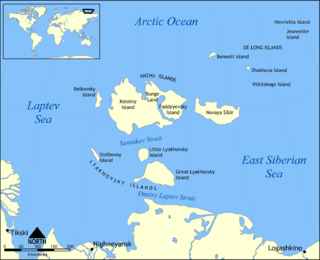
The New Siberian Islands are an archipelago in the Extreme North of Russia, to the north of the East Siberian coast between the Laptev Sea and the East Siberian Sea north of the Sakha (Yakutia) Republic, of which they are administratively a part.

New Siberia is the easternmost of the Anzhu Islands, the northern subgroup of the New Siberian Islands lying between the Laptev Sea and East Siberian Sea. Its area of approximately 6,200 square kilometres places it the 102nd largest islands in the world. New Siberia Island is low lying, rising to only 76 metres and covered with tundra vegetation. The island is a part of the territory of Yakutia, Russia.

The mammoth steppe, also known as steppe-tundra, was once the Earth's most extensive biome. During glacial periods in the later Pleistocene it stretched east-to-west, from the Iberian Peninsula in the west of Europe, across Eurasia to North America, through Beringia and northwest Canada; from north-to-south, the steppe reached from the Arctic southward to southern Europe, Central Asia and northern China. The mammoth steppe was cold and dry, and relatively featureless, though climate, topography, and geography varied considerably throughout. Certain areas of the biome—such as coastal areas—had wetter and milder climates than others. Some areas featured rivers which, through erosion, naturally created gorges, gulleys, or small glens. The continual glacial recession and advancement over millennia contributed more to the formation of larger valleys and different geographical features. Overall, however, the steppe is known to be flat and expansive grassland. The vegetation was dominated by palatable, high-productivity grasses, herbs and willow shrubs.
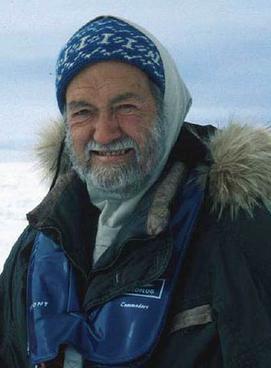
Sir Walter William Herbert was a British polar explorer, writer and artist. In 1969 he became the first man fully recognized for walking to the North Pole, on the 60th anniversary of Robert Peary's disputed expedition. He was described by Sir Ranulph Fiennes as "the greatest polar explorer of our time".

A drifting ice station is a temporary or semi-permanent facility built on an ice floe. During the Cold War the Soviet Union and the United States maintained a number of stations in the Arctic Ocean on floes such as Fletcher's Ice Island for research and espionage, the latter of which were often little more than quickly constructed shacks. Extracting personnel from these stations proved difficult and in the case of the United States, employed early versions of the Fulton surface-to-air recovery system.

Wrangel Island is an island of the Chukotka Autonomous Okrug, Russia. It is the 92nd largest island in the world and roughly the size of Crete. Located in the Arctic Ocean between the Chukchi Sea and East Siberian Sea, the island lies astride the 180th meridian. The International Date Line is therefore displaced eastwards at this latitude to keep the island, as well as the Chukchi Peninsula on the Russian mainland, on the same day as the rest of Russia. The closest land to Wrangel Island is the tiny and rocky Herald Island located 60 kilometres to the east. Its straddling the 180th meridian makes its north shore at that point both the northeasternmost and northwesternmost point of land in the world by strict longitude; using the International Date Line instead those respective points become Herald Island and Alaska's Cape Lisburne.

Lyuba is a female woolly mammoth calf who died c. 42,000 years ago at the age of 30 to 35 days. She was formerly the best preserved mammoth mummy in the world, surpassing Dima, a male mammoth calf mummy which had previously been the best known specimen.
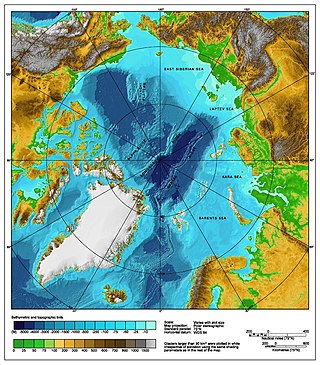
Arktika 2007 was a 2007 expedition in which Russia performed the first ever crewed descent to the ocean bottom at the North Pole, as part of research related to the 2001 Russian territorial claim, one of many territorial claims in the Arctic, made possible, in part, because of Arctic shrinkage. As well as dropping a titanium tube containing the Russian flag, the submersibles collected specimens of Arctic flora and fauna and apparently recorded video of the dives. The "North Pole-35" manned drifting ice station was established.

The woolly mammoth is an extinct species of mammoth that lived from the Middle Pleistocene until its extinction in the Holocene epoch. It was one of the last in a line of mammoth species, beginning with the African Mammuthus subplanifrons in the early Pliocene. The woolly mammoth began to diverge from the steppe mammoth about 800,000 years ago in Siberia. Its closest extant relative is the Asian elephant. The Columbian mammoth lived alongside the woolly mammoth in North America, and DNA studies show that the two hybridised with each other.
The Jarkov Mammoth, is a woolly mammoth specimen discovered on the Taymyr Peninsula of Siberia by a nine-year-old boy in 1997. This particular mammoth is estimated to have lived about 20,000 years ago. It is likely to be male and probably died at age 47.
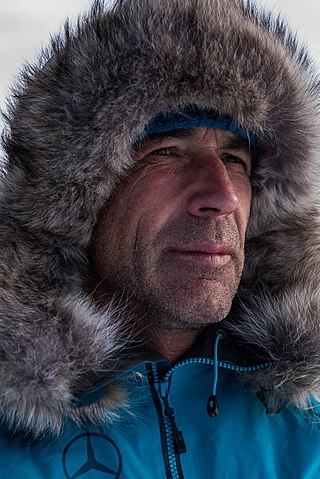
Michael Horn is a South African-born Swiss professional explorer and adventurer. Born in Johannesburg, South Africa, he currently resides in Château d'Œx, Switzerland. He studied Human Movement Science at Stellenbosch University in Western Cape, South Africa. Horn is currently undertaking his latest expedition Pole2Pole, a two-year circumnavigation of the globe via the two poles.
Shane Christopher Lundgren is an American aviator, and businessman who is the CEO of Metolius Aviation Capital. Shane has been active in commercial aviation operations, aircraft and engine leasing, and finance throughout his career.
Dick "Sir Mammoth" Mol is a Dutch paleontologist - a specialist in the field of mammoths for almost three decades. He is a research associate of several museums. Mol's primary focus is on mammals of the Quaternary period, including mammoths and extinct rhinoceros species.
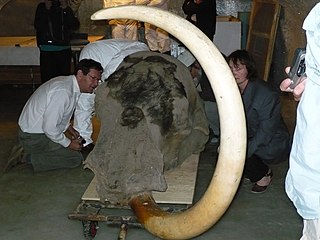
The Yukagir Mammoth is a frozen adult male woolly mammoth specimen found in the autumn of 2002 in northern Yakutia, Arctic Siberia, Russia, and is considered to be an exceptional discovery. The nickname refers to the Siberian village near where it was found.

Jean-Louis Étienne is a French doctor, explorer and scientist. He is well known for his Arctic explorations, where he was the first man to reach the North Pole alone in 1986, and his Antarctic explorations, including the famous 1990 International Trans-Antarctica Expedition.
The history of exploration by citizens or subjects of the Russian Federation, the Soviet Union, the Russian Empire, the Tsardom of Russia and other Russian predecessor states forms a significant part of the history of Russia as well as the history of the world. At 17,075,400 square kilometres (6,592,850 sq mi), Russia is the largest country in the world, covering more than a ninth of Earth's landmass. In the times of the Soviet Union and the Russian Empire, the country's share in the world's landmass reached 1/6. Most of these territories were first discovered by Russian explorers. Contiguous exploration in Eurasia and the building of overseas colonies in Russian America were some of the primary factors in Russian territorial expansion.














